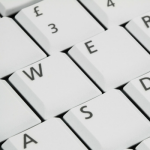 Do you know how to type?
Do you know how to type?
The fine art of typing involves more than using one or two index fingers to “hunt and peck”. In fact, after learning how to type, you should find it difficult to go back to hunting and pecking.
Typing is the process of utilizing all ten fingers, fanned out across your keyboard, so that each key is only ever pressed by it’s designated finger.
You might already be thinking “What?! But there are 27 letters, not to mention numbers and punctuation! Even If I used my toes I don’t have enough digits!”
Typing does not require you to turn into a contortionist. The answer is very simple: Each finger has several designated keys to press.
Typing should not require that you even glance at your keyboard; your eyes can be on the screen, or even elsewhere, at all times.
With a little practice it can quickly become second nature.
You might also end up like me, capable of typing at an above-average speed, but still best friends with my backspace key. (In all fairness, the backspace key does have a designated finger, so using it is still typing. That’s my story and I’m sticking to it.)
There are various tools available online where you can test your typing skills. You can find out not only your speed (measured in WPM, or “words per minute”) but also your accuracy.
I like the 10 Fast Fingers typing test.
The highest recorded WPM was 216, while the average is 41. (Source)
Distractions are certainly a factor. I average 68 WPM when left alone in peace and quiet, but only manage about 59 WPM when my brother is hanging over my shoulder spouting out random words that I am not supposed to be typing.
We’re not going to discuss my sister’s average of 110 WPM. It’s scary. I get dizzy just watching her. But she is proof that practice makes perfect; she practiced a lot!
Next week, to continue this 3-part series on how to type, we’re going to detour a little and learn a few things about the keyboard. After that, we’ll have to get down to the nitty-gritty, and actually touch one.
